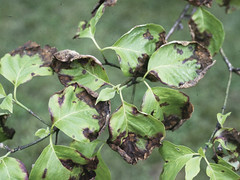 Dogwood anthracnose leaf blotch.
Dogwood anthracnose leaf blotch.
Photographer: Mary Ann Hansen, Virginia Polytechnic Institute and State University, Bugwood.org. Dogwood anthracnose (Discula destructive) is a fungus that appeared simultaneously on both coasts of the United States in the mid-1970s, origin unknown.
It forms purple-rimmed tan blotches on the leaves, and cankers on the twigs of our beautiful flowering dogwood. Lower branches often die first, and the trunk may produce a lot of sprouting as a last-ditch (but ill-fated) attempt to survive.1
Healthy trees may be able to survive a bout with the fungus, but trees stressed from drought or other problems can die within a few years—sometimes within months. Early removal of infected parts may help the tree survive (taking care to disinfect the pruning tools with rubbing alcohol between cuts).
The spores of the fungus can be splashed by rain or carried by other means, such as insects, birds, and pruning tools. Some trees seem to be resistant.
Flowering dogwood trees are valued for their beauty in early spring and because their fall berries feed many birds.


